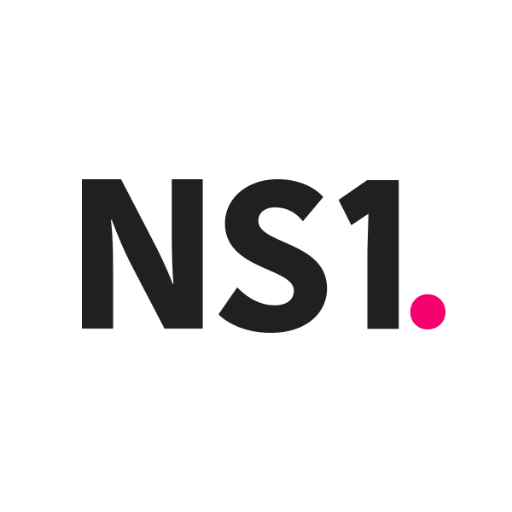NS1
Connect NS1 with Webflow to manage DNS with traffic routing based on real-time telemetry and geographic data.

How to integrate NS1 with Webflow
NS1 connects to Webflow at the DNS layer for complete control over traffic management while maintaining Webflow's visual development capabilities. Use this integration for geographic traffic routing to reduce latency, automated failover when monitoring detects site issues, or DNS automation in CI/CD pipelines.
You can integrate using manual DNS configuration for most configurations. Or build custom automation using the NS1 API and Webflow API for advanced scenarios like automated DNS provisioning in CI/CD pipelines or dynamic record management based on Webflow CMS changes.
Configure DNS records manually
Manual DNS configuration connects NS1-managed domains to Webflow sites without requiring code. This method requires initial setup plus DNS propagation time. You maintain full control over DNS records while Webflow handles hosting, SSL certificates, and CDN distribution automatically.
This integration requires the following DNS records in NS1:
- Add a paid Site plan in Webflow and configure the custom domain under Site settings > Publishing > Production
- Create two A records with hostname
@pointing to75.2.70.75and99.83.190.102 - Add a
CNAMErecord with hostnamewwwpointing to eitherproxy-ssl.webflow.comorcdn.webflow.com(check your Webflow domain settings for the correct endpoint) - Create a
TXTrecord with hostname_webflowcontaining your verification code from Webflow
DNS propagation takes up to 48 hours, though changes often appear within a few hours. SSL certificate generation happens automatically after domain verification.
Note: NS1 is not supported by Webflow's Quick Connect service, making manual configuration the standard approach for NS1 users.
Build with Webflow and NS1 APIs
API integration enables automated DNS management, dynamic record updates based on CMS content, and custom traffic routing logic. This approach suits DevOps workflows where DNS configuration integrates with deployment pipelines, or scenarios where Webflow CMS changes trigger DNS updates automatically.
Both platforms provide REST APIs. NS1 uses API key authentication via the X-NSONE-Key header, while Webflow supports Bearer token authentication with Site Tokens or OAuth 2.0.
Note: NS1 implements rate limiting using a token bucket algorithm with endpoint-specific limits. Monitor rate limit headers to prevent service interruptions.
#### Automate DNS provisioning
Automated DNS provisioning integrates zone and record creation into deployment workflows. Use this pattern when spinning up new Webflow sites programmatically or managing multiple client sites through a single control plane.
Your automation script can perform these DNS management operations:
- List all zones with
GET /zonesto retrieve active DNS zones - Create new zones using
POST /zoneswith JSON body containingzone,ttl,refresh,retry,expiry, andnx_ttlparameters - Manage DNS records through
POST /zones/{zone}/recordsfor creation andGET/PUT/DELETEendpoints for complete CRUD operations - Retrieve Webflow sites with
GET /v2/sitesto list accessible sites for automation workflows
Your automation script calls the Webflow API to create or configure a site, then calls NS1 API endpoints to provision DNS zones and create the required A and CNAME records pointing to Webflow's infrastructure. This removes manual DNS configuration for each new site.
Sync CMS content to DNS records
CMS-driven DNS updates enable dynamic infrastructure changes based on content management. Configure Webflow webhooks to trigger DNS updates when CMS content changes, useful for routing traffic based on content structure or managing subdomain mappings for multi-tenant applications.
Webflow webhook events trigger DNS automation:
- Trigger DNS updates on content changes using
collection_item_createwhen new CMS content is added - Update DNS records dynamically with
collection_item_changewhen CMS content is modified - Clean up DNS entries using
collection_item_deletewhen CMS items are removed - Coordinate with publishing through
site_publishto synchronize DNS changes with content deployment
Validate webhook authenticity using x-webflow-timestamp and x-webflow-signature headers. Implement HMAC-SHA256 signature verification before processing webhook payloads.
Set up webhook endpoints using POST /sites/{siteId}/webhooks in Webflow. Your webhook handler receives CMS change notifications, extracts relevant data from the payload, and calls NS1's record management APIs to update DNS configuration accordingly.
What you can build
Integrating NS1 with Webflow enables enterprise-grade web infrastructure with intelligent traffic management.
- Global marketing sites with geographic optimization - Build multi-regional marketing sites where NS1's Filter Chain routes visitors to the closest Webflow-hosted content based on real-time latency data, reducing page load times across continents.
- High-availability product sites with automated failover - Create product showcase sites where NS1 health checks monitor Webflow site availability and automatically route traffic to backup infrastructure if the primary site experiences issues.
- Multi-tenant SaaS marketing with dynamic subdomain routing - Deploy customer-specific landing pages as Webflow CMS items where webhook automation creates subdomain DNS records in NS1 for each new customer signup.
- A/B testing infrastructure with DNS-level traffic splitting - Implement marketing experiments by deploying multiple Webflow sites and using NS1's traffic steering to distribute visitors across variants based on custom percentages or user attributes. Note that DNS caching at the browser and ISP level can affect real-time traffic distribution precision.
Frequently asked questions
DNS propagation typically completes within a few hours but can take up to 48 hours for full global propagation. NS1 offers near-instant propagation from their authoritative nameservers, but external DNS resolvers cache records based on your TTL settings. Lower TTL values enable faster updates but increase query load on NS1's infrastructure. After DNS records propagate successfully, Webflow automatically generates SSL certificates and enables HTTPS for your custom domain.
Yes, NS1's Filter Chain technology works with Webflow-hosted sites by routing traffic at the DNS level before requests reach Webflow's infrastructure. Filter Chain enables automated traffic routing based on real-time telemetry including geographic location, network performance, and health check status. Configure multiple A records pointing to different infrastructure endpoints and use NS1's filters to distribute traffic. This pattern supports geographic optimization where different regions see content from the closest Webflow-hosted location, or failover scenarios where NS1 routes to backup infrastructure if health checks detect Webflow site issues.
Webflow's standard configuration uses
Arecords for apex domains. CreateArecords pointing to75.2.70.75and99.83.190.102for your apex domain. Use a standardCNAMErecord pointing toproxy-ssl.webflow.comfor thewwwsubdomain. This configuration pattern works reliably across all DNS providers including NS1.Yes, automate DNS updates by combining Webflow webhooks with NS1 API calls. Configure webhooks for the
site_publishevent usingPOST /sites/{siteId}/webhooksto receive notifications when sites go live.Your webhook endpoint processes these events and calls NS1's record management API to create or update DNS records dynamically. This pattern enables automated subdomain provisioning, dynamic traffic routing based on deployment status, or DNS record cleanup during site decommissioning. Implement proper webhook signature verification using
x-webflow-timestampandx-webflow-signatureheaders before processing events.

Description
NS1 (now IBM NS1 Connect) is a managed DNS and intelligent traffic management platform that operates 26 global points of presence. The platform uses Filter Chain, a system that applies sequential routing rules based on real-time network data, for automated traffic routing decisions based on telemetry. NS1 provides REST APIs for programmatic DNS management, enabling DevOps integration and supporting infrastructure-as-code workflows through Terraform and Ansible. The platform handles 5 million DNS queries per month on free developer accounts and offers unlimited API access.
This integration page is provided for informational and convenience purposes only.

GoDaddy
Connect your GoDaddy-registered domain to Webflow hosting through automated DNS configuration.

Gandi
Connect Gandi with Webflow to point your registered domains to Webflow-hosted sites through DNS configuration.

GoDaddy DomainControl
Connect GoDaddy DomainControl with Webflow to manage DNS records and publish sites to custom domains.

One.com
Connect One.com with Webflow to manage domain registration and DNS configuration while hosting on Webflow's infrastructure, enabling centralized domain control with automated SSL certificates and global CDN performance.

Greenhouse
Connect Greenhouse's powerful applicant tracking system with Webflow to create dynamic career pages, automate job postings, and streamline your recruitment process. Display live job listings, collect applications, and maintain a seamless candidate experience without manual updates.

Wix DNS
Point your Wix domain name to Webflow

Squarespace Domains
Connect Squarespace Domains with Webflow to host sites on custom domains registered through Squarespace's registrar.

OVH
Connect OVH infrastructure with Webflow to add cloud hosting, automated deployments, and scalable storage.

One.com
Point your One.com domain name to Webflow


